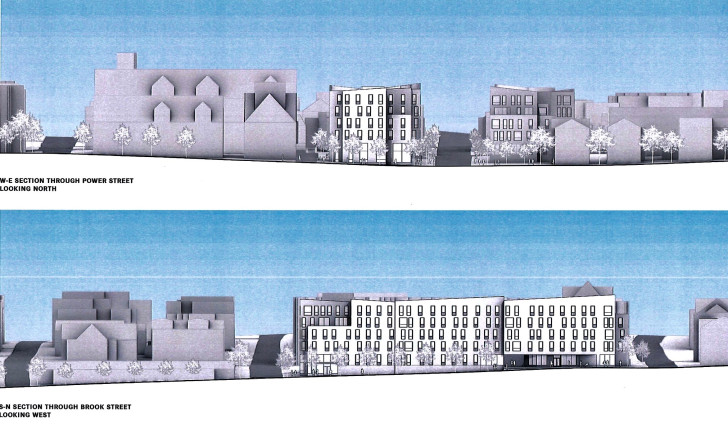Brown Versus the Neighbors, Again – Architecture Critic Morgan
Saturday, February 27, 2021
Brown is going to erect two dormitories on Brook Street. This exposes yet again the perennial tension between the university and its College Hill neighbors.
The university has doubled in size and ambition in the last half-century, and its evolution from a liberal arts college into a major research institution has exacerbated town-gown fault lines.
GET THE LATEST BREAKING NEWS HERE -- SIGN UP FOR GOLOCAL FREE DAILY EBLAST
This is not a new story. The Providence Preservation Society was founded in part as a response to the destruction of old houses to make way for the residential complex named for President Barnaby Keeney.
The sometime C.I.A. officer joined the board of the PPS, which gave him inside information on historic properties that might be ripe for plucking by the university. It was during Keeney's tenure (1955-1966), the university grew to 4,600 students and greatly expanded the graduate school.
Keeney Quad on Charlesfield Street. Conservative Georgian by an architect of Colonial Williamsburg, PHOTO: Will Morgan
Now, with Brown's growth in size (it has 7,200 undergraduates) and stature, the school wants to house 375 students on campus, allegedly relieving housing pressures in the nearby community. Since a small portion of the dorm site at Charlesfield and Power Streets lies in an historic district, the Historic District Commission held a public meeting to discuss the dorms.
Site of one of the new Brown dorms. Vartan Gregorian quadrangle to the left; parking lot is the land under review by the Historic District Commission. PHOTO: Will Morgan
The HDC's role is merely to give conceptual review (the City Planning Commission has already given its approval). Yet every commission member and witnesses spoke out against the dormitories. Beyond the issue of impacted empty lots on Power Street, the meeting was essentially a gripe session about Brown's imperiousness and lack of transparency.
Complaints centered mostly on the questions of scale, and the inappropriateness of such a massive block (five stories and 80,000 square feet) in an older streetscape. Councilman John Goncalves called the dorms "not aesthetically or functionally in tune with the neighborhood." Local resident Lily Bogosian bemoaned that the new buildings will "be a dark shadow in our lives."
PPS Director Brent Runyon described the dorms as "more like industrial mills."
Since the buildings are in Goncalves' words, "buildable by right," Brown's presentation seemed a courtesy. Project architect and Brown alumnus Noah Biklen of Deborah Berke Partners was unconvincing when he spoke of the new dorms' "strong relationship to context," how they will "reinforce the community," and be "accessible and inviting."
Stating how the design would "break down mass by subtle shifts in scale and rhythm" was no doubt similar to what was said when presenting the firm's new dorms being built for Princeton.
There are two issues here: architectural design and planning. Neighbors are right to complain about the size, massing, and scale of so many new structures erected by Brown. The once domestically scaled campus is being destroyed by such structures as the aggressively undistinguished health center and dorms on Brook Street, not to mention the ungainly performing arts center.
As to architecture, DBP is a firm with a good track record of academic work; they do handsome, tasteful, sometimes elegant, if unexciting work. But the chances of getting a future landmark from them are diminished when there are demands for superficial details that may have little to do with a design's core character. Sadly, Brown has a record of hiring good architects and underutilizing their talents, perhaps part of which is because of neighbors trying to shape designs into preconceived images.
Context is a word that was bandied about in the hearing, but it is a red herring. The 1991 Vartan Gregorian dormitory quad was mentioned several times as a paradigm of seamless College Hill context. What likely was initially a more challenging design by a firm noted for housing schemes was transformed through compromise into the epitome of blandness–more state college than Ivy League.
Similar specious contextural arguments weakened the design of the Watson Center next door by the noted architect Rafael Viñoly. A more adventurous idea that spoke to Viñoly's genius was clothed in brick, presumably to blunt local opposition.
Just across from the Watson and Vartan Gregorian is the Graduate Center, a dorm complex built in the heady revolutionary year of 1968. Far superior architecturally than either Gregorian or the Watson, its Brutalist aesthetic (that is, raw concrete) was emasculated by the brick added as a concession to the neighborhood.
Deborah Berke Partners have committed to brick cladding for the Brown dorms, no doubt to head off complaints about not fitting in. While we are grateful to preservation's guardian angels, one has to wonder if Brown's new architecture is being hamstrung by allegiance to unrealistic notions of tradition. Universities are supposed to be avatars of avant-garde design.
The PPS' Runyon said it best at the HDC meeting when he declared, "We want good design." But Brown and its neighbors will be less likely to achieve good design if we continue to argue that gables and bricks are reliable standards of outstanding collegiate architecture.
Architecture critic Morgan is a graduate of Dartmouth and Columbia, and has taught at Princeton, Louisville, Roger Williams, Wheaton, and Brown. He is the author of Collegiate Gothic: The Architecture of Rhodes College.
Related Articles
- What Will Our Houses Look Like? – Architecture Critic Will Morgan
- A Porch: Home Improvement or Architecture? – Will Morgan, Architecture Critic
- CCRI Back to the Future – Architecture Critic Will Morgan
- Handsome New Apartments on Eighth Street – Architecture Critic Will Morgan
- Embracing Sidewalk Culture – Architecture Critic Morgan
- Saving Pawtucket One Project at a Time – Architecture Critic Will Morgan
- SLICE: The Inhabited Facade – Architecture Critic Will Morgan
- Fox Point Success Story: Architecture Critic Will Morgan
- Newport’s New Hotel Would Be Fine Almost Anywhere Else, Omaha or Albany — Architecture Critic Morgan
- Fabulous Fascitelli Engineering Center at URI - Architecture Critic Morgan
- Architecture in a Time of a Pandemic– Architecture Critic Morgan
- Post Pandemic Providence – Architecture Critic Will Morgan
- RIPTA’s New Bust Shelters––Architecture Critic Morgan
- A New Gateway for Pawtuxet Village – Architecture Critic Morgan
- The Best and Worst of New Construction on the East Side–– Architecture Critic Morgan
- Two East Side Apartment Blocks –– Architecture Critic Morgan
- Providence’s New Apartments: Wrong Building, Wrong Place –– Architecture Critic Will Morgan
- A Modest Proposal for Smith Street –– Architecture Critic Morgan
- In Praise of the Post Office –– Architecture Critic Morgan
- Urban Wish List – Architecture Critic Morgan
- The Invasion of the Over-Scaled Buildings––Architecture Critic Will Morgan
- RI’s Celebrated Architect St. Florian Breaking the Code in Fox Point – Architecture Critic Morgan
- Brown’s New Policy Toward Old Houses –– Architecture Critic Morgan
- The Post-COVID Office –– Architecture Critic Morgan
- Brown Versus the Neighbors, Again – Architecture Critic Morgan










